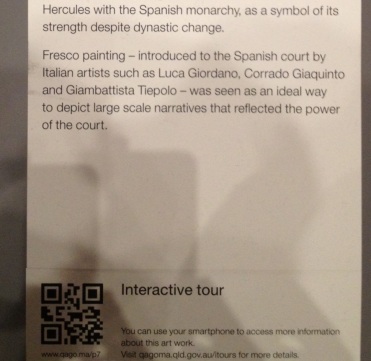In October last year I received an email from Deaf Services Queensland and the Australian Communication Exchange (ACE) inviting deaf consumers to the Portraits of Spain: Masterpieces of the Prado exhibition at the Queensland Art Gallery/Gallery Of Modern Art (QAG/GOMA). The exhibition was made accessible to people who use Australian Sign Language (Auslan) using the OpenMi Smart Auslan app developed by ACE, coinciding with the national week of deaf people.
Being hard of hearing and possessing some basic Auslan skills, I was curious to see the Smart Auslan app in action. I must admit art exhibitions being primarily a visual experiences I did wonder if the Smart Auslan app would a tad be superfluous – given that the majority of exhibits already have interpretative signs. But when you consider that some deaf people cannot access the guided tours and/or may not have proficient written English, the Smart Auslan app makes sense. The app is also designed to provide accessible information for other cultural events and places so it has great potential to improve access for deaf and hard of hearing consumers.
Below is description of my experience using the Smart Auslan app. Remember that I am not a native Auslan signer, so I’m assuming the Auslan content was accurate. I was primarily interested in how usable the app was in practice for anyone with a basic understanding of smartphone technology.
Set up
I used an iPhone 4S with iOS6 software to test the app. Upon arriving at exhibition it took me a good ten minutes connect to the WiFi, load the app and figure out how to use it. Then I had to wait for all 55 in-app items to load before commencing the tour. To be fair, the gallery suggests uploading the app and content prior to arriving – that’s all very sensible but in a spontaneous visit this wouldn’t happen. If you had no WiFi of 3G access this might ruin your day out – best to upload content before you arrive then. At the time QAG/GOMA did not provide Smart Auslan on in-house devices.

Content
The app has an Auslan interpreter explaining how to use Smart Auslan in a ‘how to’ video. This is a good start but it lacks detail – there was not enough information about how to use the Quick Response (QR) scanner. I’d suggest adding a few words explaining that the QR scanner reads the QR code automatically – no need to stand there pressing the home button repeatedly like I did…
The fifty five items I uploaded onto the app were for selected exhibits or groups of exhibits. These items consisted of short videos of about three to eight minutes with both Auslan and captioned content. This information can only be accessed by scanning the relevant QR code next to the exhibit.
Operation
Using the Smart Auslan app is pretty simple. You access information about each exhibit via the QR scanner – just line up the QR code on the phone’s screen, wait for phone to read the code and the Auslan content loads automatically. Not having much experience with QR scanners, it to took me about five scans to work this out. But once I realised I needn’t press any buttons and simply waited for the phone to read the QR code, it was easy. The hardest part was trying to access the QR code amongst the throng of fellow visitors.
Being a basic Auslan signer, I relied mainly on the captions to interpret information about each exhibit. One thing I didn’t like was that the captions were sometimes obscured by the phones onscreen volume control bar. To remedy this, I’d suggest removing the Smart Auslan logo and shifting content player’s frame upwards. It’s probably my biggest gripe about the app because it impacts on accessibility.
In practice I didn’t find the app that intuitive to use – there are separate menus for selecting your venue, managing content and accessing the QR scanner. I think this is partly because I’m used to navigating apps to find information instead of using a QR reader to access it. There is some room for improving the app layout and I’d like the option of finding in-app content without need to scan a QR code too – say you want to refer back to some content you saw earlier in the tour without backtracking to the exhibit.
Does the concept work well in practice?
Ok, so the app is pretty good. There are some opportunities to improve the user experience but the app itself does the job of providing access very nicely. However in the context of visitor experience – i.e. using the app within the venue – there are a few things I found wanting:
In the gallery the location of the QR codes was not great. Bending down for a few minutes trying to scan the codes while others are peering over you trying to read the information is a pain. Literally. I suggest placing the QR codes on poles at waist height say half a metre to one side from the exhibit. This allows you to scan the QR code easily without impacting on other patrons.
Accessibility of Auslan content needs more consideration. The exhibition included around ninety to one hundred exhibits, fifty five of which were Auslan accessible. I don’t recall seeing fifty five QR codes so I question this. However the QR codes applied to groups of items in some cases so this may account for the difference.
The in-app videos generally explained the history behind different genres. Now I’m not an art buff so I did find it a little laborious and my neck got a bit sore staring at my phone. Going to see art is a highly visual experience and I actually felt the app detracted from my experience somewhat – I spent probably 50% of my time looking at smart Auslan and rather than taking in the paintings themselves. That is a slightly cynical view but it does reflect my experience. That said if you’re a mad keen art buff or art student who happens to be deaf, this app will enhance your experience. Just don’t expect too much technical detail from the in-app videos.
The Auslan content appears to be a summarised version of the interpretative signs next to each exhibit. From a pure accessibility point of view, the Auslan content falls a little short of the mark but in a practical sense it is probably adequate – you are on your feet for quite some time and short ‘soundbites’ (no pun intended) are easier to take in as you move around. QAG/GOMA also display a kids version of the signs which is commendable – I actually prefer the simplicity of the kids version. So there may be some scope to better replicate the interpretative signs in Auslan – maybe a detailed version for the art buffs and a short version for everyone else.
While I was using the app there were large groups circulating with tour guides. Where the Smart Auslan app would really shine is if the Auslan content replicated the content the guides presented in verbal form. It doesn’t have to be verbatim, but a close approximation would be great. For a deaf person following a tour guide with a group of hearing friends, the Smart Auslan app would really enhance the experience.
Conclusion
ACE and QAG/GOMA are to be congratulated for their efforts in developing the Smart Auslan app. Clearly a lot of thought, time and energy has gone into producing the app and the Auslan content and this will greatly enhance the experience of deaf and hard of hearing consumers.
Overall rating: 4/5.
Hits:
- Broad application across many cultural experiences and events
- Improves access to information for both deaf and hard of hearing consumers
- iOS and Android version available
Misses:
- App layout needs some tweaking to enhance intuitive user experience
- QR code locations could be improved
- QAG/GOMA should consider lending in-house devices to improve accessibility.



Smart Auslan: A user's experience – accessible communications : User Experience Design Rx